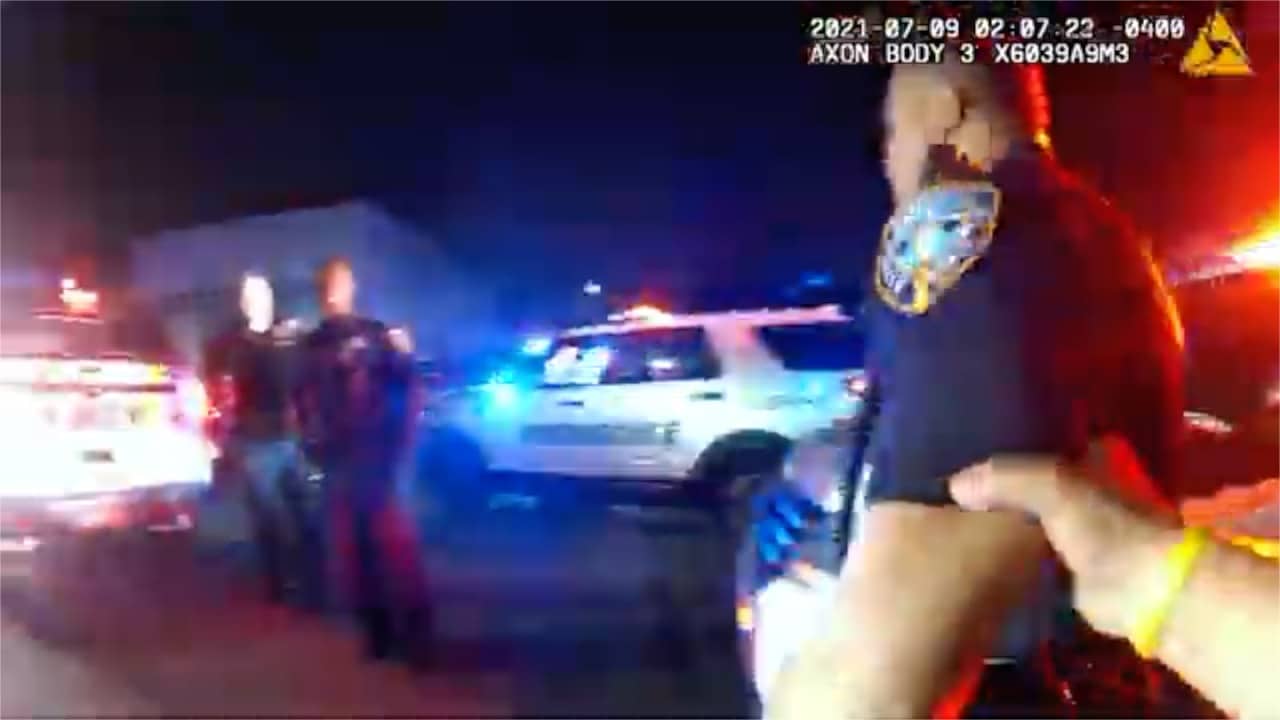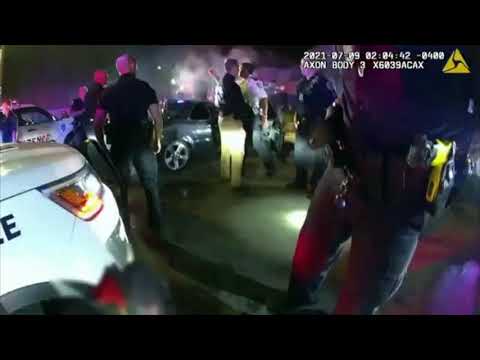AG Neronha fails to bring charges against officer who beat and spit on juvenile in custody
“Following a 3-day presentation of witnesses and evidence by prosecutors before the grand jury, the grand jury returned a “no true bill,” declining to charge PVD Police Officer Domingo Diaz with simple assault against one of the juveniles involved,” said the Attorney General’s office in a statement.
March 30, 2022, 2:16 pm
By Steve Ahlquist
In police body camera footage of an incident from July 9, the alleged driver of the vehicle, a juvenile, is dragged from the car, handcuffed and beaten. Though the Providence Police Department acknowledged that the suspect was injured when the car crashed into the fire hydrant, the juvenile’s still drag his body around, despite the fact that he could have sustained serious head, neck and spinal cord injuries. After being restrained the juvenile was punched in the head repeatedly and his neck is contorted violently, while being restrained by multiple officers.
One officer, Domingo Diaz, in apparent rage and after the juvenile had been restrained, screamed, “Are you fucking kidding me?” before spitting on or near the juvenile. Later, Officer Diaz can be seen and heard to be apparently screaming at three women, one visibly pregnant.
Today, the office of Attorney General Peter Neronha reports that his office has failed to get an indictment against Officer Diaz.
“Following a 3-day presentation of witnesses and evidence by prosecutors before the grand jury, the grand jury returned a “no true bill,” declining to charge PVD Police Officer Domingo Diaz with simple assault against one of the juveniles involved,” said the Attorney General’s office in a statement.
According to the Attorney General:
“As has been previously publicly reported, on July 9, 2021, members of the Providence and Pawtucket Police departments responded to numerous reports of individuals shooting weapons from an SUV and dark convertible BMW. Multiple callers reported being shot in the face, head and body with BB guns. There were also reports of property damage. Police officers in pursuit were advised to assume that the weapons involved might be actual firearms, given the uncertainty based on public reports regarding the nature of the weapons involved.
“After a 40-minute pursuit through multiple cities and towns, during which the operator of the vehicle pointed what appeared to be a rifle at one of the pursuing officers, the BMW crashed into a fire hydrant. Body-worn camera footage showed that the driver and rear passenger put up their hands in response to police commands. The front passenger did not. While the driver and rear passenger were taken into custody without further incident, multiple officers engaged in a struggle with the front passenger that lasted approximately one minute, before placing him under arrest.
“The suspect was wearing a fanny pack across the front of his body, and at various times his hands and arms were unsecured and beneath his body in the vicinity of the fanny pack. Multiple officers stated in interviews that, based on their training and experience, they know fanny packs are frequently used to hide firearms. Body-worn camera footage depicted Providence Police Officer Domingo Diaz and others striking the front passenger multiple times in the head and neck area and torso. Officer Diaz’s use of force occurred over approximately 20 seconds. Other officers also reported using force during the arrest of this individual, though their actions were not visible on video.
“The Office of Attorney General retained two separate use-of-force experts to review the actions of the officers involved. One of the experts found that the officers acted reasonably based upon the circumstances they were facing. A second expert found that some of the initial strikes were excessive and unreasonable, but could not render a conclusive opinion as to all of the strikes delivered.“
This is the latest in a series of incidents where Attorney General Peter Neronha has failed to secure indictments or bring charges against law enforcement officers.
- In 2019 AG Neronha brought no charges against a Wyatt Correctional Facility prison guard who drove his ruck through peaceful protesters or the nearly two dozen prison guards who left the Wyatt to assault the panicked and injured crowd.
- In 2021 AG Neronha declined to bring charges after Jhamal Gonsalves was severely injured after a Providence Police cruiser injured him.
- No charges were brought against officers for pepper spraying children in 2021 on Sayles Street.
Here’s the rest of the Attorney General’s release, outlining their thinking:
Determining excessive use of force
Unlike members of the public, law enforcement officers are permitted to use appropriate force in the execution of their duties, including to gain control of a suspect, eliminate a threat to officer and public safety, and effectuate an arrest. Providence Police policy and training permits the use of force, including closed fist strikes, for these purposes. However, an officer’s use of force can go too far, subjecting the officer to potential criminal (and civil) liability. The United States Supreme Court has held that in order to find an officer criminally liable for assault in connection with a use of force incident, a trial jury (or, in the first instance, a grand jury) must engage in a two-part inquiry.
First, the jury must determine whether the officer’s use of force in making the arrest was objectively reasonable and necessary. The Officer’s subjective intent, or “malice,” is not relevant to this stage of the inquiry. Graham v. Connor, 490 U.S. 386, 399 (1989). “An officer’s evil intentions will not make a Fourth Amendment violation out of an objectively reasonable use of force; nor will an officer’s good intentions make an objectively unreasonable use of force constitutional.” Id. at 397.
In other words, it does not matter what is in a particular officer’s head at the time of an encounter with the public. What matters is what a reasonable officer would do in the same situation.
The Supreme Court has held that the degree of force that is reasonably permissible depends upon the totality of the circumstances of the actual seizure. Relevant facts include “the severity of the crime at issue, whether the suspect poses an immediate threat to the safety of the officer or others, and whether he is actively resisting or attempting to evade arrest by flight…” Id. at 396. The determination of reasonableness must allow “for the fact that police officers are often forced to make split-second judgements – in circumstances that are tense, uncertain, and rapidly evolving….” Id. at 396-97.
If a jury (or grand jury) finds that the officer’s use of force was objectively reasonable and necessary, the jury’s (or grand jury’s) inquiry ends there. If, however, the jury (or grand jury) determines that the use of force was objectively unreasonable and unnecessary, then the jury (or grand jury) must move to the second stage of the inquiry, and determine whether the conduct at issue meets the elements of the applicable criminal offense – in this case Simple Assault and/or Battery under R.I. Gen. Laws §11-5-3. Under Rhode Island law, an assault is an unlawful offer to do bodily injury to another, whether from malice or wantonness. State v. Lomba, 37 A.3d 615, 620 (R.I. 2012). A criminal charge is appropriate only where there is probable cause to believe that the force used was unreasonable or unnecessary and the conduct meets the elements of §11-5-3.
A grand jury is required to evaluate the evidence against this legal standard.
“The grand jury is a critical part of our criminal justice system. The grand jurors in this matter worked hard to carefully sort through all the testimony and evidence that was presented to them – including body-worn camera footage, use-of-force expert testimony, witness accounts, and reports from both the Providence Police Department and Rhode Island State Police,” said Attorney General Peter F. Neronha. “The legal and factual issues involved in this case were complex and not easy ones for the grand jurors to grapple with. As with all members of the public who give their time to perform this important criminal justice function, I am grateful to them for their service.”
Public disclosure
Under current Rhode Island law, absent an indictment, proceedings before the grand jury are secret. This Office is therefore precluded in this case from publicly disclosing grand jury materials, including transcripts of grand jury testimony. Attorney General Neronha has, for each of the past three years, and again this year, introduced legislation that would allow for the public release of such grand jury material and the preparation of a grand jury report in certain instances, notwithstanding the absence of an indictment. The Attorney General believes that such a law would increase transparency and buttress confidence in the grand jury process.
Recognizing, however, that at present Rhode Island law remains unchanged, the Office made every effort to document this investigation prior to presenting evidence before the grand jury. Accordingly, there is a significant amount of investigative material that may be shared with the public. That material is available on the Attorney General’s website here.
The Office previously authorized the release of body camera footage by the Providence Police Department in response to an Access to Public Records Act (APRA) request and consistent with Office policy and guidance from the Supreme Court Ethics Advisory Panel. That footage is available here.
The Attorney General is grateful to the Rhode Island State Police and the Providence Police Department Office of Professional Responsibility for their partnership in this joint investigation.
The criminal cases against the three juveniles remain pending in Rhode Island Family Court.







